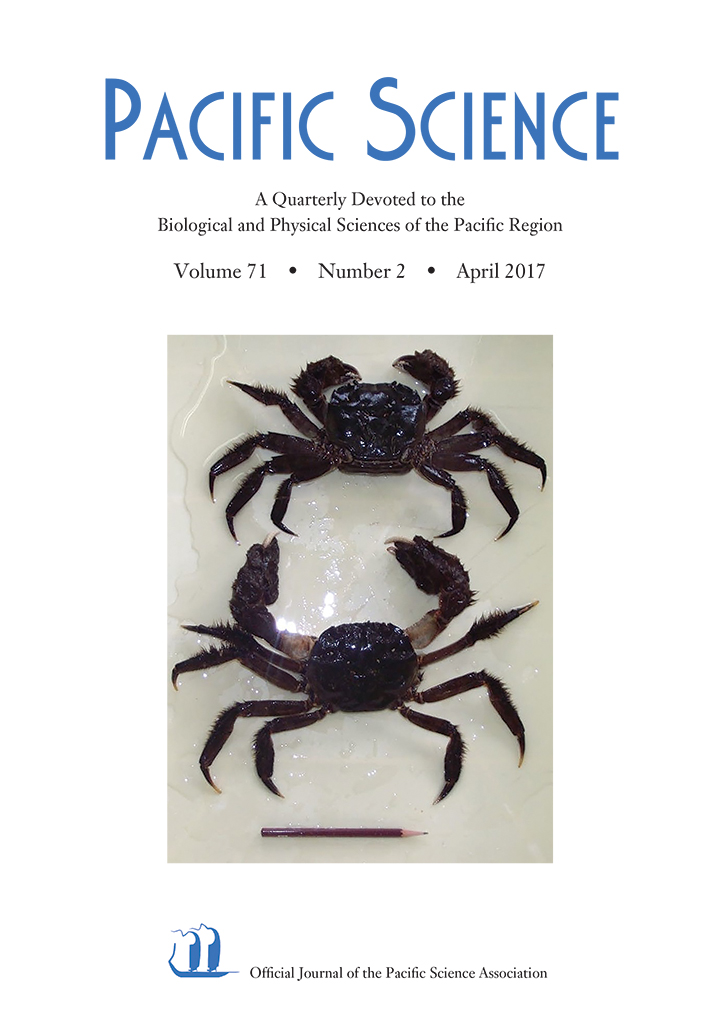
This quarterly issue of Pacific Science explores new research about Pacific crabs, fish, plankton, birds, grass, frogs, and eels.
The opening article examines fish in the aftermath of the 2011 Tohoku 9.0 magnitude earthquake and tsunami at the Fukushima Daiichi Nuclear Power Plant. From the abstract:
Thirteen commonly consumed types of fish caught in the North Pacific and locally available in Hawai‘i were analyzed using gamma spectroscopy to measure Fukushima-derived and historic 134Cs and 137Cs isotopes. All fish samples had detectable 137Cs above 95% confidence intervals. Three out of the thirteen samples had 134Cs, an isotope indicative of Fukushima releases, detected above 95% confidence intervals. The highest 134Cs and 137Cs concentration in the examined species was in ‘ahi tuna, carrying 0.10 ± 0.04 Bq/ kg and 0.62 ± 0.05 Bq/ kg, respectively. Other samples with 134Cs activities found above their 2-sigma uncertainty were albacore tuna and swordfish. Historic and Fukushima-derived contributions were evaluated, and in several samples the Fukushima-derived radiocesium dominated the total radiocesium inventory with up to 61% contribution. All activities were below derived intervention limits of 1,200 Bq/ kg, and the doses to humans from consuming the fish attributable to radiocesium were 0.02 – 0.2 μ Sv, in comparison to 6 – 20 μ Sv contributed by the natural 40K present in the same fish.
Scholarly articles in this issue:
- In the Wake of Fukushima: Radiocesium Inventories of Selected North Pacific Fish by Hannah R. Azouz and Henrietta Dulai
- Root Functional Diversity of Native and Nonnative C3 and C4 Grass Species in Hawai‘i by Courtney L. Angelo and Stephanie Pau
- Natural History Observations of Hawaiian Garden Eels, Gorgasia hawaiiensis (Congridae: Heterocongrinae), from the Island of Hawai‘i by Emily Donham, Michael S. Foster, Marc R. Rice, Gregor M. Cailliet, Mary M. Yoklavich, and Scott L. Hamilton
- Breeding Status of the Red-tailed Tropicbird (Phaethon rubricauda) and Threats to Its Conservation on Easter Island (Rapa Nui) by Marcelo Flores, Pedro Lazo, Graciela Campbell, and Alejandro Simeone
- Wide-ranging Movement and Foraging Strategy of the Critically Endangered Red-headed Wood Pigeon (Columba janthina nitens): Findings from a Remote Uninhabited Island by Haruko Ando, Tetsuro Sasaki, Kazuo Horikoshi, Hajime Suzuki, Hayato Chiba, Michimasa Yamasaki, Yuji Isagi
- Difference in Body Size and Sexual Dimorphism in the Ogasawara Mitten Crab, Eriocheir ogasawaraensis, and the Japanese Mitten Crab, Eriocheir japonica by Satoshi Kobayashi and Kiyoshi Satake
- First Record and Description of Panulirus pascuensis (Reed, 1954) First-Stage Phyllosoma in the Plankton of Rapa Nui by Erika Meerhoff, Armando Mujica, Michel García, and María Luisa Nava
- New Species and Records of Crabs of the Families Dromiidae, Dynomenidae, Homolidae, Aethridae, Parthenopidae, Majidae, and Epialtidae (Crustacea: Decapoda: Brachyura) from Easter Island, with a Review of the Majid Genus Schizophroida Sakai, 1933 by Peter K. L. Ng and Christopher B. Boyko
- Nematoda of Eleven Species of Ranid Frogs (Anura: Ranidae) from Southeast Asia by Stephen R. Goldberg, Charles R. Bursey, and L. Lee Grismer
Find the full text of the issue at BioOne
 About the Journal
About the Journal
Appearing quarterly since 1947, Pacific Science is an international, multidisciplinary journal reporting research on the biological and physical sciences of the Pacific basin. It focuses on biogeography, ecology, evolution, geology and volcanology, oceanography, paleontology, and systematics.
Subscriptions
Individual subscription is by membership in the Pacific Science Association. Institutional subscriptions available through UH Press.
Submissions
Contributions to the biological and physical sciences of the Pacific area are welcomed from authors in all parts of the world. See Pacific Science‘s submission guidelines for details.




